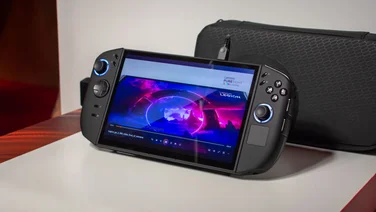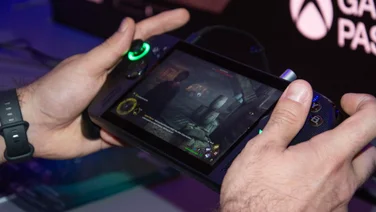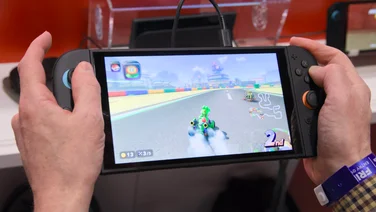To help us provide you with free impartial advice, we may earn a commission if you buy through links on our site. Learn more

Following what feels like years of rumours, Apple has finally admitted that it’s been developing an augmented reality headset, with the announcement of the Apple Vision Pro. Looking like a cyberpunk scuba mask, the Apple Vision Pro is the brand’s first step into what it calls “spatial computing”, and is apparently so special that Apple filed more than 5,000 patents during its development.
READ NEXT: Best iPhone

The headset is powered by a dual-chip system, comprising one Apple M2 processor alongside a new R1 chip, which has been designed specifically for the Vision Pro. This processes input from the sensors and headphones with the aim of reducing lag, to avoid the potential for motion sickness. These chips power some impressive-looking visuals, too, with a full 4K HDR Micro OLED display cramming 23 million pixels across two postage stamp-sized panels.
It looks suitably futuristic, with a single piece of polished, laminated glass sitting on the front of the visor, behind which sits a bank of cameras and sensors that scan and map the space around you. The frame is constructed from aluminium alloy and the rest of the headset is modular, allowing you to find the best fit for your face and head shape. Apple has said the light seal around the visor will apparently be available in a range of shapes and sizes, as will the wide, stretchy “knitted” headband.
And, for glasses users, Apple will make a selection of custom Zeiss optical inserts available, removing the need to wear your glasses while interacting with the Vision Pro. Of course, expect to pay through the nose for these.
Finally, power is supplied via either the mains or a tethered battery (to reduce the weight in the headset itself). At this stage, Apple is quoting two hours of use before the headset needs to be recharged.
Apple Vision Pro: So what is it for?
If the hardware looks exciting, it’s the software that will make or break the Vision Pro, and it appears that Apple is playing things pretty safe here. At the heart of things lies Apple’s new spatial operating system, which it calls VisionOS. It’s this that will deliver the heart of the user journey behind the Vision Pro headset, blending digital content with the physical world.
App icons will hover in your living room, responding dynamically to the lighting and even casting shadows. Controls are handled by your eyes, hands and voice: you simply look at apps to scroll to them, tap your fingers to select items and use your voice to dictate text. Although this is the main control scheme, the Vision Pro is also compatible with physical peripherals such as the Magic Keyboard and Magic Trackpad, as well as games controllers.

Apple is calling Vision Pro a hybrid reality headset but, in the first instance, the Vision Pro is designed for augmented reality, allowing you to effectively live within a spatial world of Apple’s design while remaining aware of the world around you.
You’ll be able to run apps, watch movies or respond to messages and, whenever someone approaches you in the real world, the headset’s EyeSight feature will automatically turn the visor semi-transparent, allowing others to see your eyes and you to watch them back. If you’re busy using an app or are otherwise unavailable, the visor will display a particular light pattern, like a high-tech VR do-not-disturb sign.
You can even run FaceTime calls with friends and family within the Vision Pro with spatial audio delivering directional sound. And, to get around the fact that the headset has no selfie camera, VisionOS can create a digital avatar for you called a Persona. This uncanny valley resident is created using machine learning, and can map your facial expressions and hand movements by tracking them with in-headset sensors.

Although the Vision Pro has no selfie camera, you can capture the outside world using the headset’s three-dimensional camera. Using this, you can take photos and videos of your view, including spatial audio capture, for boosted immersion when revisiting them. It’s hard to envisage quite how this is going to work for regular photos and videos at this stage but easy to see how panoramic photos would look quite impressive.
And, of course, this being a hybrid headset, you can also use Vision Pro like a typical VR device. You can watch 4K movies on your own adjustable 100-foot wide screen and play games, all fully immersed in 3D unreality. Apple says there will be more than 100 Apple Arcade games available at launch, with promised support for a “popular games controller” to add to the experience.
The announcement showed a PlayStation DualSense controller being used, and we expect the Xbox controller to be supported as well. Audio pods built into the headband can also deliver spatial audio on compatible services, saving you the need to pair external earbuds.
READ NEXT: Best iPad
Apple Vision Pro: Price and availability
The Apple Vision Pro looks pretty impressive but it isn’t going to come cheap. In fact, at $3,499 (there’s no UK pricing right now) the cost is sky high compared with other VR headsets. Only the Microsoft Hololens 2, which isn’t aimed at consumers in any way, comes close with prices around the £3,500 mark.
And even then, if you fancy splashing out, you’re going to have to wait, with availability restricted to the US only initially starting from “early next year” (2024). Apple says it will be available in other countries later in 2024, so expect to see a more concrete UK release date in the near future.






